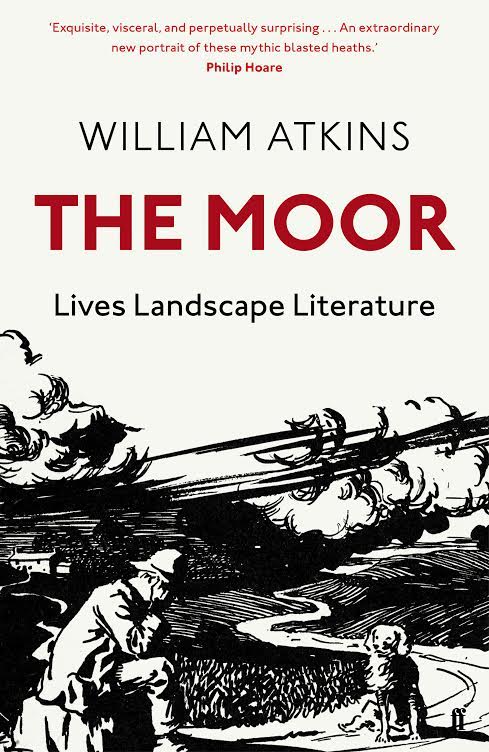The Moor: Lives Landscape Literature
by William Atkins
Faber, 400 pages. Out now.
Reviewed by Ben Myers
If the woodlands are the lungs of the land and the rivers the veins through which the lifeblood of Britain courses, then the moors must surely be something less intangible. The subconscious perhaps – that great untapped area so infrequently enjoyed or inhabited.
The national psyche has it that nothing good happens up on these damp, dark elevated places that form a backbone up through Britain. Historically the moors belong to doomed Cathy and savage, cast-out Heathcliff. To Myra and Ian, trudging through the Saddleworth sod with spade and torch and tape recorder. To cinematic American students lost in the fog as something skulks and growls, off-screen and unseen, Brian Glover’s words echoing in their ears. The moors belong to howling hounds and crime scene cordons. To soil so acidic it can corrode concrete dams and runnels, and in which nothing worthwhile (translation: consumable) can grow.
William Atkins understands these perceptions of the moors as mysterious and barren places. In undertaking a journey inspired by time spent surveying and exploring a local moor as a child (he has since realised it was not even moorland, but fen) he explores the many facets of the English highlands and succeeds in presenting places that, though tied up with our own mythologies, are far more complex and magical than we realise.
It’s a visceral and joyous account, one in which Atkins’ prose seeps and bubbles, foams and drips; each page is alive with sphagnum, kaolin, wolfram and growan. Take for example this sentence in which he describes Bodmin Moor: “Beyond the white-grey of moss-spotted clitter, the moor sank through chartreuse slopes, down to the dulled emerald intake of Penhale Farm, to a motley lowland of pale lime dashed with tawny and dun and faun, and then the intricate tapestry of purple moor-grass, cotton-grass, mat-grass, heather, moss and lichens: chamois, bronze, taupe, walnut – a hennaed mouldering, rusty vastness shot with saffron, carmine and topaz, with swathes of reflectivity that shimmered like raffia in the low sun.”
Journeying England from south to north, the varied moors he crosses and whose history he seeks to understand clearly bring the best out of Atkins, his keen eye for detail in turn bringing the landscape to life and finding poetry in that which less imaginative people would find ordinary. He describes a cow as having an “infected right eye like a blown light bulb” and a lapwing that rises “like a paperback blasted from a cannon”
This book is so good it seems pedantic to pick up on an error, which, in taking in the same breathless views of Calderdale enjoyed by an adolescent Ted Hughes, places the valley that was so defining to the young poet as being South rather than West Yorkshire – a little like confusing Kent with Essex (though Hughes did grow up in both).
I note this only because the observations of this valley in which I too live are so acutely accurate, Atkins paying as much attention to the edgelands and borders as the moors themselves – the narrow gorges and the crags and cliffs, like Scout Rock, in whose shadow I write this review and which Hughes described: “living beneath it was like living in a house haunted by a disaster that nobody can quite believed ever happened, though it regularly upsets sleep.” Atkins notes that to Hughes this near-vertical cliff face acted as a gateway to the moors, an impassable barrier “as unforgiving as the Atlantic or outer space” and beyond which the rest of the world waited. Here the moors are not oppressive but alluring. They are the bridge between low-valley living and everything the planet has to offer (“To the west,” Hughes once wrote, “Manchester, Liverpool….and New York.”)….
Atkins not only explores the geology and ecology and the vastly varied moorlands from Bodmin and Exmoor up through Dartmoor, Saddleworth, the Calder valley and the hilltop dramas of North Yorkshire, but the stories that infuse them too. Literary representations provide key moments, but perhaps Atkins’ real strength beyond his impeccable writing, is his personalisation of the moors. He digs deep into the peat to unearth lesser known stories of lives lead in, on or around the moorlands – those of bogland proselytizers, misanthropic isolationists, failed farmers, majestic monastery-building monks, eccentric priests (including one who memorably excommunicated his cat “for mousing on a Sunday”) publicans, miners, lost ramblers, writers in retreat and, of course, bodies buried.
A pattern emerges: the moors cannot be tamed. History tells us that even the most ambitious empire builders have failed to work the soil to their advantage for any length of time. There’s a reason why these spaces remain untamed and untilled and have escaped the insidious sprawl of suburbia at the hands of those town planners and property developers out to make a quick buck.
Because unlike woodlands that can be chopped down and razed to their smoking stumps or ponds and lakes that can be dammed or filled in and covered over, the moors are a more nebulous terrain. They are harsh and wet and unforgiving and for that reason occupy a special corner of the human imagination. Atkins serves them well and might just have written a comprehensively researched and poetically-rendered future classic.
Will Atkins will be among our guests at the Port Eliot festival in July and Festival No 6 in September.
Buy The Moor from the Caught by the River shop at the special price of £16.00
Ben Myers’s book Beastings will be published by Blue Moose Books on 4 July.
